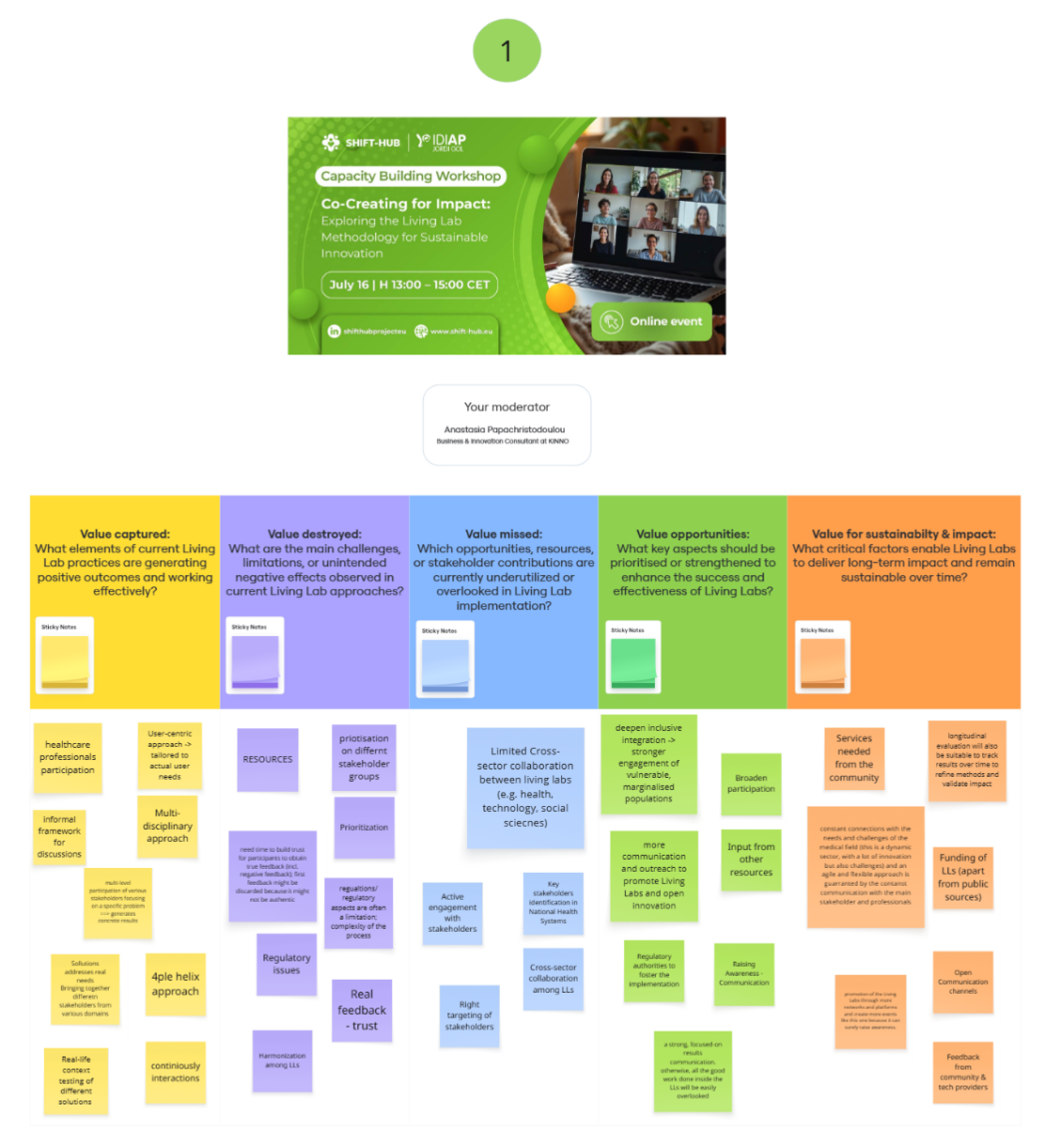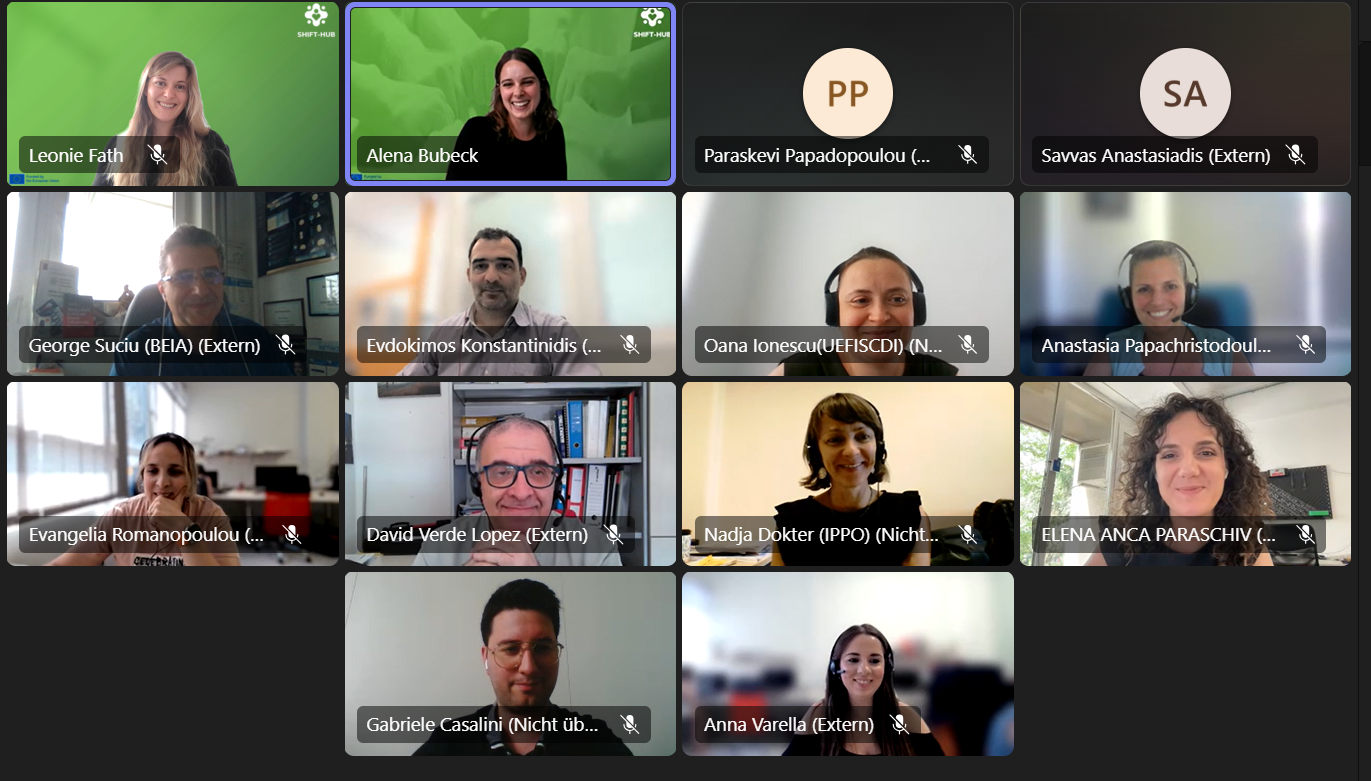July 16, 2025
The SHIFT-HUB project, funded by the European Commission, co-organised an engaging online Capacity Building Workshop in collaboration with IDIAPJGol titled “Co-Creating for Impact: Exploring the Living Lab Methodology for Sustainable Innovation “ on July 16, 2025. The event aimed to strengthen participants’ knowledge and capacity by showcasing how Living Lab methodologies can drive sustainable innovation and create meaningful outcomes. Additionally, the workshop provided a platform to explore key challenges and opportunities within the current Living Lab landscape across the European innovation ecosystem, with a focus on fostering long-term impact.
The workshop consisted of two sessions, a keynote lecture session and an interactive workgroup session. The keynote session brought together distinguished representatives from innovation ecosystems who shared their experiences, expertise and approaches in implementing Living Labs. The event concluded with a collaborative session that encouraged participants to exchange insights and jointly map the key values of Living Lab methodologies within the European innovation landscape.
Key Highlights
Speakers and Presentations:
The workshop was moderated by Alena Bubeck, coordinator of the SHIFT HUB project and project manager at Steinbeis Europa Zentrum. She introduced SHIFT-HUB, the project’s objectives and services, before welcoming the following distinguished speakers:
- Evangelia Romanopoulou, Research Assistant at the Lab of Medical Physics at the Medical School of Aristotle University of Thessaloniki (AUTH), where she actively contributes to a variety of funded research and exploitation projects. Evangelia introduced the concept of Living Labs, why they matter and how they can advance open innovation and stakeholder engagement.
- Annita Varella, Research Assistant also at the Medical Physics and Digital Innovation Laboratory in the School of Medicine of the Aristotle University of Thessaloniki (AUTH).
Annita provided an overview of the Living Lab approach used in the SHIFT-HUB project. She shared examples of Living Lab activities in Thessaloniki’s Thess-AHALL Living Lab and showcased several currently running projects.
- Evdokimos Konstantinidis, Leader of the Assistive Technologies and Silver Science Research Group in the Medical Physics and Digital Innovation Lab at Aristotle University of Thessaloniki (AUTH), Chairperson of the European Network of Living Labs (ENoLL) and coordinator of the Health and Wellbeing Living Labs Action Oriented Task Force. Evdokimos introduced to the ENoLL network and its role in shaping innovation.
- David Verde, Innovation Officer at IDIAPJGol Research institute and promoter of AITAP, a Spanish alliance of different National Health Services. David shared their Living Lab approach at IDIAPJGol implemented in primary care units.
Interactive Group Sessions
The interactive workshop facilitated discussions, value mapping, and showcasing focusing on the central question:
“How can Living Lab methodologies be enhanced to improve outcomes, overcome key challenges, and foster long-term impact?”
Participants explored in small groups the effectiveness of existing Living Lab approaches, identified inefficiencies, and proposed actionable recommendations to enhance Living Lab implementation strategies across Europe (Errore. L’origine riferimento non è stata trovata.).

Key Insights & Value Mapping
- Value Captured: What elements of current Living Lab practices are generating positive outcomes and working effectively?
- Active participation of healthcare professionals
- Ensures that solutions are grounded in real-world clinical needs and practical expertise.
- User-centric approach to address real needs
- Focuses on designing and developing solutions tailored to actual user needs, improving relevance, usability and adoption.
- Ensures that outputs are meaningful and applicable, by integrating input from various sectors and user groups.
- Informal framework for discussion
- Creates an open, flexible environment that fosters trust, creativity, and inclusive dialogue.
- Multi-level stakeholder participation and continuous interaction
- Brings together diverse actors around a shared challenge, resulting in more actionable outcomes.
- Maintains momentum and stakeholder engagement throughout the process, enabling iterative refinement and long-term value.
- Multi-disciplinary collaboration aligned with the Quadruple Helix model
- Integrates perspectives, knowledge and expertise from academia, industry, public sector, and civil society to tackle complex challenges more effectively.
- Supports holistic innovation with broader societal relevance.
- Real-life context testing
- Validates solutions in authentic environments, improving real-world effectiveness, scalability, and uptake.
- Value Destroyed: What are the main challenges, limitations, or unintended negative effects observed in current Living Lab approaches?
- Time required to build trust
- Establishing trust among stakeholder groups is essential for obtaining authentic feedback, especially critical feedback, but it requires significant time and effort.
- Early-stage feedback from participants might not reflect true experiences or needs, leading to potential misdirection in solution development.
- Prioritisation of different stakeholder groups
- Imbalances in stakeholder representation can lead to partial perspectives, skew project outcomes and reduce inclusivity in the co-creation process.
- Regulatory barriers and complexity
- Legal and regulatory frameworks can pose significant barriers, particularly in healthcare settings, slowing down or complicating implementation.
- Challenges in receiving real and authentic feedback
- Stakeholders may hesitate to share negative feedback without established trust or safe communication spaces, which limits opportunities for meaningful improvement.
- Lack of harmonisation among Living Labs
- Variability in methodologies, structures, and goals across Living Labs creates fragmentation and limits scalability, comparability of results and hinders shared learning.
- Value Missed: Which opportunities, resources, or stakeholder contributions are currently underutilized or overlooked in Living Lab implementation?
- Limited active engagement with stakeholders
- While stakeholders may be present, deeper and more consistent engagement is often lacking, reducing their meaningful contribution to the process.
- Insufficient identification of key stakeholders in national health systems
- A lack of strategic mapping and inclusion of relevant actors limits alignment with health system priorities and scalability of solutions.
- Inadequate targeting of stakeholders
- Without correctly identifying and involving the most relevant stakeholders at each phase, co-creation efforts may lack direction or fail to meet user needs.
- Limited cross-sector collaboration among Living Labs
- Existing silos between domains such as health, technology, and social sciences restrict interdisciplinary innovation and holistic solution development.
- Underutilised collaboration between Living Labs
- Greater cooperation and knowledge exchange between different Living Labs could lead to shared learning, improved practices, and more impactful outcomes.
- Value Opportunities: What key aspects should be prioritised or strengthened to enhance the success and effectiveness of Living Labs?
- Deepen inclusive integration
- Ensure stronger engagement of vulnerable and marginalised populations to create more equitable and representative solutions.
- Broaden stakeholder participation
- Expand involvement across different sectors and user groups to enrich perspectives and foster more comprehensive co-creation.
- Leverage input from additional resources
- Incorporate insights and support from underused actors, sectors, or knowledge sources to strengthen the innovation process.
- Enhance communication and outreach to raise awareness
- Promote the Living Lab model and principles of open innovation more actively to increase visibility, understanding, and stakeholder interest.
- Build greater recognition of the role and benefits of Living Labs through strategic awareness campaigns and targeted messaging.
- Focus on results-driven communication
- Clearly communicate outcomes and impact to avoid the valuable work of Living Labs being overlooked or undervalued.
- Involve regulatory authorities at an early stage
- Engage with regulators from the outset to facilitate smoother implementation pathways and ensure compliance with legal and ethical standards.
- Value for Sustainability and Impact: What critical factors enable Living Labs to deliver long-term impact and remain sustainable over time?
- Strong alignment with community needs
- Continuously provide services that are relevant and needed by the community to maintain engagement and practical value.
- Diversified and sustainable funding sources
- Explore funding avenues beyond public sources, including private partnerships and service-based models, to ensure financial sustainability.
- Longitudinal evaluation of outcomes
- Implement ongoing assessment mechanisms to track progress, refine methodologies, and validate long-term impact.
- Responsive and agile connection to the medical field
- Maintain constant communication with healthcare professionals to adapt to evolving needs, ensuring agility and relevance in a rapidly changing sector.
- Promotion through networks and events
- Increase visibility and stakeholder buy-in by engaging in broader innovation networks and organising events that raise awareness and share best practices.
- Open communication channels
- Establish transparent, two-way communication with all stakeholders to build trust and ensure ongoing collaboration.
- Regular feedback from communities and tech providers
- Collect and integrate feedback to improve solutions, strengthen partnerships, and reinforce co-creation dynamics.
Outcomes and Takeaways
The Capacity Building Workshop on “Co-Creating for Impact: Exploring the Living Lab Methodology for Sustainable Innovation” successfully brought together key stakeholders from across European innovation ecosystems. Through insightful presentations, interactive discussions, and value-mapping exercises, the workshop highlighted both the opportunities and challenges in implementing Living Labs, especially in the healthcare sector.
The workshop emphasised that Living Labs are successfully creating value through user-centred design, real-life testing, and multi-stakeholder collaboration. Key challenges include time-intensive trust-building, regulatory barriers, and limited harmonisation across Labs. Participants identified missed opportunities in stakeholder engagement and cross-sector collaboration, particularly in health systems. To enhance impact and sustainability, priorities should include broader participation, improved communication, engagement with regulators, and long-term evaluation. Strengthening these areas will be essential to unlock the full potential of Living Labs and ensure lasting outcomes.


